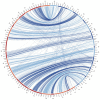QTL Analysis of Five Morpho-Physiological Traits in Bread Wheat Using Two Mapping Populations Derived from Common Parents
- PMID: 33923933
- PMCID: PMC8074140
- DOI: 10.3390/genes12040604
QTL Analysis of Five Morpho-Physiological Traits in Bread Wheat Using Two Mapping Populations Derived from Common Parents
Abstract
Traits such as plant height (PH), juvenile growth habit (GH), heading date (HD), and tiller number are important for both increasing yield potential and improving crop adaptation to climate change. In the present study, these traits were investigated by using the same bi-parental population at early (F2 and F2-derived F3 families) and late (F6 and F7, recombinant inbred lines, RILs) generations to detect quantitative trait loci (QTLs) and search for candidate genes. A total of 176 and 178 lines were genotyped by the wheat Illumina 25K Infinium SNP array. The two genetic maps spanned 2486.97 cM and 3732.84 cM in length, for the F2 and RILs, respectively. QTLs explaining the highest phenotypic variation were found on chromosomes 2B, 2D, 5A, and 7D for HD and GH, whereas those for PH were found on chromosomes 4B and 4D. Several QTL detected in the early generations (i.e., PH and tiller number) were not detected in the late generations as they were due to dominance effects. Some of the identified QTLs co-mapped to well-known adaptive genes (i.e., Ppd-1, Vrn-1, and Rht-1). Other putative candidate genes were identified for each trait, of which PINE1 and PIF4 may be considered new for GH and TTN in wheat. The use of a large F2 mapping population combined with NGS-based genotyping techniques could improve map resolution and allow closer QTL tagging.
Keywords: F2; QTL; RILs; SNP markers; bread wheat; genetic map.
Conflict of interest statement
The authors declare no conflict of interest.
Figures



Similar articles
-
Analysis of genetic control and QTL mapping of essential wheat grain quality traits in a recombinant inbred population.PLoS One. 2019 Mar 6;14(3):e0200669. doi: 10.1371/journal.pone.0200669. eCollection 2019. PLoS One. 2019. PMID: 30840619 Free PMC article.
-
QTLs Associated with Agronomic Traits in the Cutler × AC Barrie Spring Wheat Mapping Population Using Single Nucleotide Polymorphic Markers.PLoS One. 2016 Aug 11;11(8):e0160623. doi: 10.1371/journal.pone.0160623. eCollection 2016. PLoS One. 2016. PMID: 27513976 Free PMC article.
-
Mapping QTLs for grain yield components in wheat under heat stress.PLoS One. 2017 Dec 19;12(12):e0189594. doi: 10.1371/journal.pone.0189594. eCollection 2017. PLoS One. 2017. PMID: 29261718 Free PMC article.
-
Genome-wide association study of heading and flowering dates and construction of its prediction equation in Chinese common wheat.Theor Appl Genet. 2018 Nov;131(11):2271-2285. doi: 10.1007/s00122-018-3181-8. Epub 2018 Sep 14. Theor Appl Genet. 2018. PMID: 30218294 Review.
-
Controlled Environment Ecosystem: A Cutting-Edge Technology in Speed Breeding.ACS Omega. 2024 Jun 26;9(27):29114-29138. doi: 10.1021/acsomega.3c09060. eCollection 2024 Jul 9. ACS Omega. 2024. PMID: 39005787 Free PMC article. Review.
Cited by
-
Genomics for Yield and Yield Components in Durum Wheat.Plants (Basel). 2023 Jul 7;12(13):2571. doi: 10.3390/plants12132571. Plants (Basel). 2023. PMID: 37447132 Free PMC article. Review.
-
Unlocking the molecular basis of wheat straw composition and morphological traits through multi-locus GWAS.BMC Plant Biol. 2022 Nov 8;22(1):519. doi: 10.1186/s12870-022-03900-6. BMC Plant Biol. 2022. PMID: 36344939 Free PMC article.
-
Genomic regions of durum wheat involved in water productivity.J Exp Bot. 2024 Jan 1;75(1):316-333. doi: 10.1093/jxb/erad357. J Exp Bot. 2024. PMID: 37702385 Free PMC article.
-
High-Density Linkage Mapping of Agronomic Trait QTLs in Wheat under Water Deficit Condition using Genotyping by Sequencing (GBS).Plants (Basel). 2022 Sep 27;11(19):2533. doi: 10.3390/plants11192533. Plants (Basel). 2022. PMID: 36235399 Free PMC article.
-
Whole-exome sequencing of selected bread wheat recombinant inbred lines as a useful resource for allele mining and bulked segregant analysis.Front Genet. 2022 Nov 22;13:1058471. doi: 10.3389/fgene.2022.1058471. eCollection 2022. Front Genet. 2022. PMID: 36482886 Free PMC article.
References
-
- FAO Early Outlook for 2021 Crops. [(accessed on 15 April 2021)];2021 Available online: http://www.fao.org/worldfoodsituation/csdb/en/
-
- Hunter M.C., Smith R.G., Schipanski M., Atwood L.W., Mortensen D.A. Agriculture in 2050: Recalibrating targets for sustainable intensification. Bioscience. 2017;67:386–391. doi: 10.1093/biosci/bix010. - DOI
-
- Barrett B., Bayram M., Kidwell K., Weber W.E. Identifying AFLP and microsatellite markers for vernalization response gene Vrn-B1 in hexaploid wheat using reciprocal mapping populations. Plant Breed. 2002;121:400–406. doi: 10.1046/j.1439-0523.2002.732319.x. - DOI
Publication types
MeSH terms
LinkOut - more resources
Full Text Sources
Other Literature Sources
Miscellaneous

